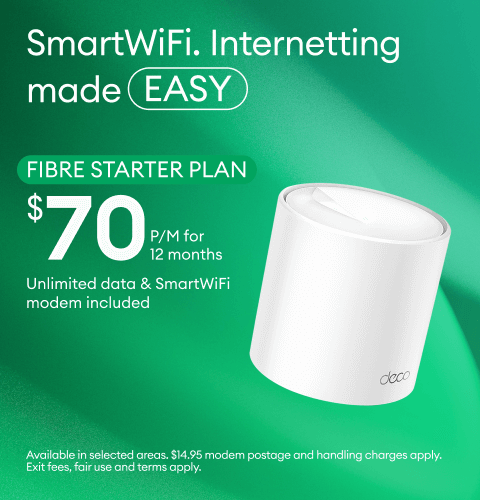Understanding Broadband Speeds
Plus, get some troubleshooting tips to help improve your online experience.


Who supplies the internet to me and how?
Broadband (aka the internet) is delivered to your home via a network , either wired, or wireless.
Wireless Broadband runs over our 4G and 5G mobile networks, using the same technology that your mobile phone uses to access the internet.
Wired broadband connections can be delivered in various ways, depending on your physical location and the type of connection/s available at your address. The Fibre network covers most residential areas in New Zealand now, but more remote areas are covered by Copper networks, which means ADSL and VDSL, or Rural Broadband networks (links to RBI).
The Fibre and Copper networks are owned by Local Fibre Companies (LFCs), who provide a physical connection to your home. Internet Service Providers (ISPs) like One NZ pay these LFCs a monthly fee to access this physical connection so we can provide an internet connection inside your home for you to use (your monthly broadband plan).
Your connection enables you to access the internet using hardware provided by us (where applicable) and it's supported by our customer service team.
For a view of the types of broadband available to you, check out our broadband plans page.
What is WiFi - and why do we use it?
WiFi (Wi-Fi) is the abbreviation of Wireless Fidelity. It's a radio technology that allows computers other devices to communicate with each other without needing to be plugged in using a network cable.
Whilst a wired connection offers the very best performance (and therefore is used as the true measure connection performance in the MBNZ quarterly testing), most households are using WiFi to connect their devices these days - and that's all about convenience.
WiFi is handy, allowing us to use devices wherever we want to in our homes, however there are many things that can impact your WiFi signal and therefore the coverage, connection and speed experience. Getting your WiFi equipment set up correctly and using things such as a Mesh WiFi solution like our SuperWiFi, can dramatically improve your internet experience.
For a detailed overview on WiFi performance in your home you can visit our what effects WiFi speeds page. The TCF also have another great resource on their improving Broadband performance page.
What is Mesh WiFi and how can it help me?
Mesh WiFi uses multiple nodes (two or more), to create a new in-home network, offering better coverage and therefore performance than a traditional single modem solution. Often in kiwi homes, a single modem just can’t provide enough coverage to get to all the rooms in the house. So a mesh WiFi solution solves the issue of dead spots with wall-to-wall coverage and improved speed performance.
How can I get Mesh WiFi?
One NZ has you covered with SuperWiFi, our very own mesh solution. You can find out more about this by visiting our SuperWiFi Mesh page.
What is speed and how is it measured?
Internet speed is measured in bits per second (bps). Because modern internet speeds can handle a lot of data, speed is usually reported in megabits per second (Mbps), which is one million bits per second. Or, when speeds get really, really fast, we talk in gigabits per second (Gbps), which is a billion bits per second (1,000 Mbps = 1 Gbps).
Upload vs Download speed
Download speed measures how fast information from the internet gets to your device (e.g., how long it takes for a file or webpage to download). The quicker the download speed, the faster it reaches your device and the more seamless your online experience – especially when streaming, or downloading high-quality video or new software.
On the other hand, upload speed refers to how fast information on your device is sent to another destination on the internet (e.g., sharing photos and videos on social media). For most connections, upload and download speeds are usually different and these are the numbers you will see when internet providers advertise their plans.
Latency
Another important measurement for internet speed is latency (aka "lag"). Latency is the time it takes for data to pass from one point to another. For example, from your device to your internet provider, or the servers that the content you are viewing, downloading or using is stored on - the lower the latency, the better the experience. A higher latency could lead to delays in the data transfer, which causes things like videos buffering, gaming characters slow to respond to your instruction, or interruptions to video calls.
You can check your broadband speed at our Speed Test page or check out our WiFi Help diagnostic tools.
FAQs
How are advertised speeds measured?
The speeds advertised are the average upload and download speeds experienced by customers using a similar service during the national average peak time (7pm to 11pm, Monday to Friday) at different locations across the country and using an ethernet (wired) connection.
Because they're averages, individual customers may experience different speeds during peak times - even on the same service – that can be higher or lower than advertised; they're not a personalised expectation or a guarantee.
As mentioned previously, a wired connection is used when measuring these speeds, as several situational factors can affect the performance of your internet when connecting over Wifi. To understand how WiFi works and its effect on performance, watch our WiFi tips video.
Why am I experiencing speeds different to what’s advertised?
Factors affecting performance:
Factors within your (the customer's) control
- Device performance: Older devices may not have the internal technology required to reach the full speeds on offers, and all devices (regardless of age) can run slower if they’re under heavy load or you’re using multiple applications at the same time.
- Modem performance: Older modems may not have the newer technology needed in them to process the full speeds on offer either, limiting the maximum speed you can experience.
- In-home WiFi setup (e.g. modem settings, physical location within your home) is one of the main factors affecting performance. The distance from your device to the modem, interference from objects such as walls, furniture etc between you and the modem, and the number of devices connecting via Wifi at the same time all impact performance.
- Equipment specifications and maintenance (e.g. software, viruses, malware): To get the best performance from your device, it’s important to keep up to date with device updates and software scans etc, to optimise performance.
Factors within our (One NZ's) control:
- The location of the internet sites you're connecting to can be far away so slow things down.
- Your physical distance from a cell tower can impact performance. If you’re far away from a cell tower, then your speed might not be as fast.
- One NZ’s network capability. We are constantly upgrading our network to meet increasing demand.
- Network congestion is carefully monitored so we can ease bottlenecks.
- Network outages. You can check for current network outages in our Network outages page.
- We manage the traffic on our network to provide a smooth internet experience.
To understand how WiFi works and its effect on performance, check out our WiFi tips video.
Do you have a complaint about your broadband speeds?
You can raise a complaint to us by:
- Calling 0800 800 021
- Sending a letter to Private Bag 92143, Auckland 1142, New Zealand
- Logging the complaint online on our website.
Or
- You can go to the Telecommunications Dispute Resolution Scheme (TDRS)
The TDRS is a free and independent service available to all customers who are dissatisfied with how their complaint is being dealt with by their provider. The TDRS covers is available to all kiwis at no cost.
The TDRS will try resolve your complaint with One NZ and work with you to reach a mutually acceptable settlement. One NZ is a founding member of the TDRS
For more information on the TDRS, please visit the TDRS website.





